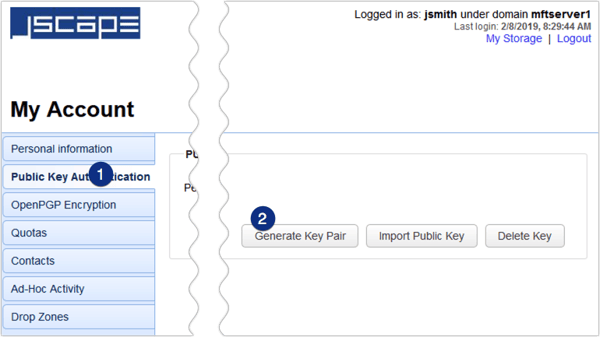Sftp Generate New Host Key
Posted : admin On 14.12.2020How do I create a host key file to use with my applications as I can not use system defined /etc/ssh/ssh_host_rsa_key for non-root account under Linux / Unix / Apple OS X / *BSD operating systems?
You need to use a command called ssh-keygen. This command generates, manages and converts authentication keys for ssh. It can create RSA keys for use by SSH protocol version 1 and RSA or DSA keys for use by SSH protocol version 2. he type of key to be generated is specified with the -t option. If invoked without any arguments, ssh-keygen will generate an RSA key for use in SSH protocol 2 connections. The -f option specifies the filename of the key file.
SFTP with WinSCP: Configuring SSH Public and Private Keys Using Cpanel Posted on 2015-06-29 by Mukesh M In order to use public and private key based authentication to SFTP to your server, you need to have SSH enabled on your hosting account.
SFTP with WinSCP: Configuring SSH Public and Private Keys Using Cpanel Posted on 2015-06-29 by Mukesh M In order to use public and private key based authentication to SFTP to your server, you need to have SSH enabled on your hosting account. Using SFTP public key authentication is a great step towards securing your sftp server. In this article, I’ll run through our step-by-step instructions for getting SFTP public key authentication working for your users, along with an explanation of the main terms. When you install a fresh system, then at the start of the ssh service, it generates the host keys for your system which later on used for authentication. But if due to some reason you need to generate the host keys, then the process is explained below. Jun 13, 2019 The idea is that you will recognize if the random art changes, and be suspicious of the connection because it means the SSH keys for that server have been altered. Installing the Public Key We need to install your public key on Sulaco, the remote computer, so that it knows that the public key.
Why create a new host key files?
Generate ssh key windows server 2012. You may need a new key file:
- Your system is compromised.
- Your keys are stolen.
- You forgotten the passphrase.
- Your application need a new host key.
- You can not read the default system key files stored in /etc/ssh/ directory but your non-root application needs key.
- You got an error message which read as “Could not load host key: /etc/ssh/ssh_host_key*”.
ssh-keygen Syntax
Sftp Private Key File
The syntax is:

Example
Create a host key file in your $HOME/.ssh/myapp as follows. First, create a directory to store your host key file, enter:$ mkdir -p $HOME/.ssh/myapp
To create a host RSAv2 key file, run:$ ssh-keygen -t rsa -f $HOME/.ssh/myapp/rsa_key_file
Sample outputs:
Type the following commands to verify the keys:$ ls -l $HOME/.ssh/myapp/
Sample outputs:
You can now use keys with your app:$ mycool-app -key $HOME/.ssh/myapp/rsa_key_file -d
ADVERTISEMENTS
Applies to: Windows Server 2019
This topic covers how to prepare Hyper-V hosts to become guarded hosts using host key attestation (Key mode). You'll create a host key pair (or use an existing certificate) and add the public half of the key to HGS.
Create a host key
- Install Windows Server 2019 on your Hyper-V host machine.
- Install the Hyper-V and Host Guardian Hyper-V Support features:
- Generate a host key automatically, or select an existing certificate. If you are using a custom certificate, it should have at least a 2048-bit RSA key, Client Authentication EKU, and Digital Signature key usage.
Sftp Generate Host Key
- Get the public half of the key to provide to the HGS server. You can use the following cmdlet or, if you have the certificate stored elsewhere, provide a .cer containing the public half of the key. Note that we are only storing and validating the public key on HGS; we do not keep any certificate information nor do we validate the certificate chain or expiration date.
- Copy the .cer file to your HGS server.
Add the host key to the attestation service
This step is done on the HGS server and allows the host to run shielded VMs. It is recommended that you set the name to the FQDN or resource identifier of the host machine, so you can easily refer to which host the key is installed on.